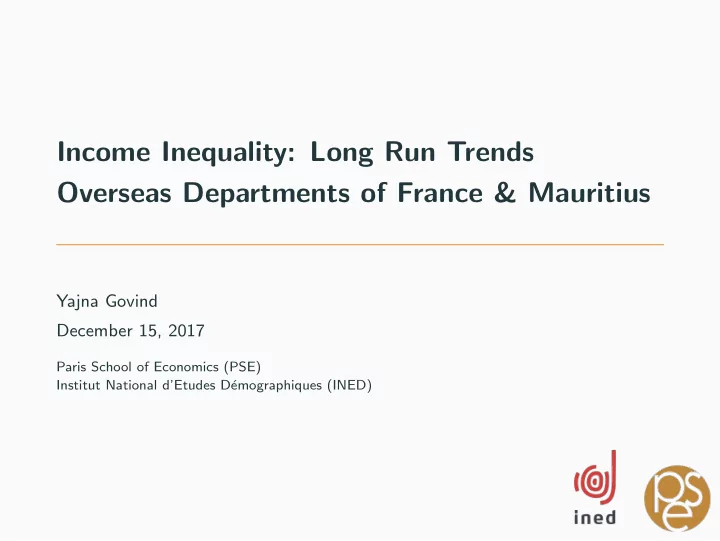

Income Inequality: Long Run Trends Overseas Departments of France & Mauritius Yajna Govind December 15, 2017 Paris School of Economics (PSE) Institut National d’Etudes D´ emographiques (INED)
Overseas Departments of France
Motivation
Motivation Intriguing cases: Developing context within a highly developed nation • Colonial history (Since 17 th century) → Departmentalisation (1946) • Ethnic Mix: White metropolitans, African ex-slaves, Indian labourers, Autochtones • Economic and Social Division • High relevance for France: historically, economically & politically • DOM- Most unequal departments of France (INSEE) 1
Motivation Intriguing cases: Developing context within a highly developed nation • Colonial history (Since 17 th century) → Departmentalisation (1946) • Ethnic Mix: White metropolitans, African ex-slaves, Indian labourers, Autochtones • Economic and Social Division • High relevance for France: historically, economically & politically • DOM- Most unequal departments of France (INSEE) “ ...In 1945, all the inhabitants of the former empire wanted to become citizens and stop being subjects...[Departmentalisation] meant the end of arbitrary rule , access to European salaries and social security ... By departmentalisation, what was sought, naively probably, but sincerely, was equality of rights . But France remained reluctant to enforce what it had voted for. I then realized that we had made a fool’s deal, and that departmentalisation was nothing but a new form of domination . “ —Aim´ e C´ esaire (1981) 1
Contribution & Results Contribution → Collecting & building a database for DOM → Long run trend of income inequality → Comparative study: Martinique, Guadeloupe & La R´ eunion since the mid-1980s 2
Contribution & Results Contribution → Collecting & building a database for DOM → Long run trend of income inequality → Comparative study: Martinique, Guadeloupe & La R´ eunion since the mid-1980s Results • Significant gap between the average income in Metropolitan France and the DOM and reduction over the period but still significant today • Top Income Shares: Much higher top 10% shares but no significant difference in top 1% between France and DOM • Lower bottom 50% shares 2
Context
Historical Context Post-departmentalisation: • Phases of Socio-economic development: 1. 1950s - 1960s: Addressing urgent sanitary and social situations 2. 1960s - 1980s: More focus on DOM-specificities & increased creation of public jobs 3. 1980s-2000: Increased effort to bring equality - Decentralisation of power: Regional Council in each DOM - Wider coverage of social benefits - Alignment of benefits to Metropolitan France: RMI, SMIC • Public Wage Premium: sur-r´ emun´ erations: premium of 53.6% in La R´ eunion & 40% in Guadeloupe, Martinique and Guyane 3
Population Guadeloupe Martinique Guyane R´ eunion 4
Current Situation • High Unemployment Rate Unemp Rate Metropolitan France DOM Unemployment Rate 10% 20 - 30% Youth Unemployment Rate (15-24 years) 25% Above 50% • Lower HDI than Metropolitan France HDI DOM (2010) HDI Level La R´ eunion Same as France 1990 Guadeloupe & Martinique Below France 2000 Guyane Below France 1990 • High Poverty Rates 5
Current Situation Poverty Rate Poverty Rate (Based on Local Poverty Threshold for DOM) Poverty Rate (2006) Source: INSEE 6
Current Situation Poverty Rate Using National Poverty Threshold: Extreme Poverty level All dept Poverty Rate (2006) Source: INSEE, Senat (INSEE, ISEE, ISPF, AFD) 6
Data & Methodology
Data Population Data RP1954 - RP2014 Income Data Year Source 1970 - 1994 INSEE (1997) 1990 - 2014 INSEE Online Database Taxation Data Year Source 1986 - 1998 Etats 1921 (Centre des Archives Economiques et Financi` eres) 2000 - 2014 Direction G´ en´ eral des Finances Publiques (DGFiP) 7
Methodology • Generalised Pareto Interpolation Technique - Blanchet et al., (2017) as used in Garbinti et al., (2017) • Control Total for Population and Income The total population and income if all tax units declared their income i) Control Total for Population Control Population = Adult Population - Number of married couples ii) Control Total for Income Taxable Income = GDP - Non-household Income - Non-taxable items 8
Methodology Control Total for Income Taxable Income → Fiscal Income : See Garbinti et al., (2017) i) 10% Lump-sum on professional expenses of wage earners ii) Additional 20% deduction on wage income (repealed in 2006) iii) Capital Gains Source: Own estimations based on DGFiP data Hence, unit of analysis is Fiscal Income & Tax Units 9
Results
Results Average Fiscal Income Average Fiscal Income Source: Own estimations based on National Income data (INSEE) and Garbinti et al (2017) for France 10
Results P90-100 Threshold P90-100 Income Threshold Source: Own estimations based on DGFiP data and Garbinti et al (2017) for France 11
Results P99-100 Threshold P99-100 Income Threshold Source: Own estimations based on DGFiP data and Garbinti et al (2017) for France 12
Main Results Top Income Shares Top 10% Share Source: Own estimations based on DGFiP data and Garbinti et al (2017) for France 13
Main Results Top Income Shares Top 1% Share Source: Own estimations based on DGFiP data and Garbinti et al (2017) for France 14
Main Results Bottom Income Shares Bottom 50% Share Source: Own estimations based on DGFiP data and Garbinti et al (2017) for France 15
t
Plausible Explanation 15
Interpretations High Top Income shares in DOM Bottom of the distribution • High unemployment rate: 20 - 30% • Lower minimum wage than Metropolitan France prior to 1996 Upper end of the distribution • Civil servants wages + Premium • Private sector high-income earners 16
Conclusion
Appendix
Poverty Rates Poverty Rate (2006) Source: INSEE Back
Current Situation Unemployment Rate Unemployment Rate (2012) Youth Unemployment Rate (2012) Back
Current Situation Human Development Index Human Development Index HDI Progress 1990-2010 Source: AFD (2012) Source: Own estimation based on AFD (2012) Back
Recommend
More recommend